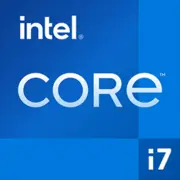Intel Core i7-1260U

Intel Core i7-1260U:2025年ウルトラブックにおけるモバイル性とパフォーマンスのバランス
妥協のないポータビリティを重視する方のためのプロセッサレビュー
アーキテクチャとプロセス:ハイブリッドアプローチのAlder Lake
Intel Core i7-1260Uプロセッサは、Alder Lakeラインの一環として発売され、Intelのハイブリッドアーキテクチャへの革命的な移行の一部となっています。これは、2つの高性能コア(P-コア)と8つのエネルギー効率の高いコア(E-コア)を組み合わせており、合計で10個の物理コアと12スレッドを提供します(P-コアはハイパースレッディングをサポートしています)。この構成は、タスクを最適に分配することを可能にします:P-コアは「重い」アプリケーションを担当し、E-コアはバックグラウンドプロセスを処理して全体のエネルギー消費を削減します。
- Intel 7プロセス(10nm Enhanced SuperFin)は、高いトランジスタ密度と改善されたエネルギー効率を提供します。
- ターボモードでの最大周波数は4.7GHzであり、シングルスレッドタスクでの瞬時の応答にとって重要です。
- 統合グラフィックスIris Xe(96 EU)は4Kディスプレイをサポートし、AIのハードウェアアクセラレーションを提供し、軽いプロジェクトでの控えめなゲームプレイを可能にします。
Iris Xeのグラフィックスは、ディスクリートGPUには勝てませんが、Photoshopでの写真編集やストリーミングビデオ、さらにはRocket Leagueのようなゲームを中設定で(40-50 FPS)実行するには十分です。
エネルギー消費とTDP:Intelがバッテリーを節約する方法
プロセッサの名目TDPは9Wですが、実際には9–29Wの範囲で動作しており、これはIntel Dynamic Tuning技術のおかげです。これにより、ノートパソコンはリソース集約型のタスクに対して一時的にパフォーマンスを向上させ、システムを過負荷にすることなく動作できます。
- PL1(長期負荷)モードでは、プロセッサは9-15Wに安定し、熱を最小化します。
- PL2(短期「ブースト」)モードでは、電力は29Wに達し、短い動画のレンダリングや「重い」アプリケーションの実行に適しています。
比較のために、前世代(Intel 11th Gen)は同等のタスクを実行する際に20–30%多くのエネルギーを消費していました。これはE-コアの最適化と電圧管理の改善によって達成されました。
パフォーマンス:オフィスから軽いゲームまで
Geekbench 6 シングルコア: 1559 / マルチコア: 5112 — これらの数字はi7-1260Uを過去のデスクトッププロセッサと同列に置きます。しかし、これは実際にはどのように現れるのでしょうか?
- オフィスタスク:Chromeで30以上のタブ、Excelスプレッドシート、Zoomとの同時作業 — ラグなし。
- マルチメディア:30分の1080p動画の変換(HandBrake)は約12分かかります。対照的に、Ryzen 7 5825Uは約14分かかります。
- ゲーム:CS:GOの中設定(1080p)で60–70 FPS、Genshin Impact(720p、低設定)で40–45 FPS。
Turbo Boostモードは高負荷時に20–30秒アクティブになりますが、コンパクトなウルトラブックでは冷却が制限されているため、周波数がすぐに低下する可能性があります。例えば、Dell XPS 13では、5分間のレンダリング後にP-コアの周波数が4.7GHzから3.8GHzに落ちます。
使用シナリオ:i7-1260Uは誰に向いているのか?
このプロセッサは以下の用途に最適です:
1. 学生やオフィスワーカー:文書の迅速な作成、ビデオ会議、マルチタスキング。
2. フリーランスのデザイナー:Figmaでの編集、Lightroomでの軽い写真処理。
3. 旅行者:コンパクトなノートパソコンで長時間のバッテリー寿命(最大10時間)。
向いていないのは:
- プロフェッショナルな3DモデリングやDaVinci Resolveでの4K動画編集。
- 外部GPUなしでのAAAゲーム。
バッテリー寿命:コンセントなしで最大10時間作業可能
ハイブリッドアーキテクチャと9WのTDPのおかげで、i7-1260U搭載のノートパソコンは印象的なバッテリー寿命を実現しています:
- ウェブサーフィン:8–10時間(明るさ50%、Wi-Fi)。
- ビデオ(Netflix):6–8時間。
- 省エネルギー技術:
- Intel Speed Shift — プロセッサの状態間の即時切り替え。
- Adaptix Dynamic Tuning — 負荷予測のための機械学習。
例えば、Lenovo Yoga 9iはこのCPUと60Whのバッテリーで、読書モードで最大11時間動作します。
競合他社との比較:AMD、Apple、過去の世代
- AMD Ryzen 7 5825U(Zen 3):8コア、16スレッド、TDP 15W。マルチスレッドタスク(例えば、レンダリング)に強いですが、シングルスレッドパフォーマンスでは劣ります(Geekbench 6で約1350)。
- Apple M2:エネルギー効率が高く(最大18時間のバッテリー寿命)、Windowsアプリケーションとの互換性が制限されています。
- Intel Core i7-1165G7(11th Gen):E-コアがないため、i7-1260Uに対してマルチタスク性能が25–30%劣ります。
i7-1260U搭載のノートパソコンの価格範囲:$1000–$1500。Ryzen 7 5825U搭載の類似品は$100–$200安いですが、Thunderbolt 4ポートの数は少なくなります。
プロセッサの長所と短所
強み:
- パフォーマンスとバッテリー寿命の理想的なバランス。
- Thunderbolt 4とWi-Fi 6Eのサポート。
- 日常的なシナリオでの静音動作(本体温度が35°Cを超えない)。
弱点:
- RyzenやApple M2に対する制限されたマルチスレッド性能。
- バジェットノートパソコンでは冷却が弱いためスロットリングが発生する可能性あり。
ノートパソコン選びの推奨項目
1. デバイスタイプ:1.3kg未満のウルトラブック(例:Asus ZenBook S 13またはHP Spectre x360)。
2. RAM:最低16GBのLPDDR5 — マルチタスク用。
3. ストレージ:512GB以上のSSD(できればPCIe 4.0)。
4. 画面:100% sRGBカバーのIPSパネル — 色作業に快適。
5. 冷却:ファンの騒音についてのレビューを確認。
2025年モデルの例:
- Dell XPS 13(2025):$1399、16GB RAM、1TB SSD、3.5K OLEDディスプレイ。
- Acer Swift 5:$1099、16GB RAM、512GB SSD、タッチディスプレイ。
最終的な結論
Intel Core i7-1260Uは、パフォーマンスを犠牲にしたくないモバイル性を求める方に最適です。これは以下のような利用に理想的です:
- オフィスアプリケーションの日常的な作業。
- コンテンツの閲覧や軽い創作活動。
- 静かで冷却されたノートパソコンを重視するユーザー。
もしAAAゲームや複雑な3Dシーンのレンダリングが必要でなければ、i7-1260Uは2025年の優れた選択肢となるでしょう。その主な利点は、バッテリー寿命、ポータビリティ、そしてほとんどのタスクに対する十分なパワーです。
基本
CPUの仕様
メモリ仕様
GPUの仕様
その他
ベンチマーク
他のCPUとの比較
ソーシャルメディアで共有する
または当サイトへのリンクを追加
<a href="https://cputronic.com/ja/cpu/intel-core-i7-1260u" target="_blank">Intel Core i7-1260U</a>